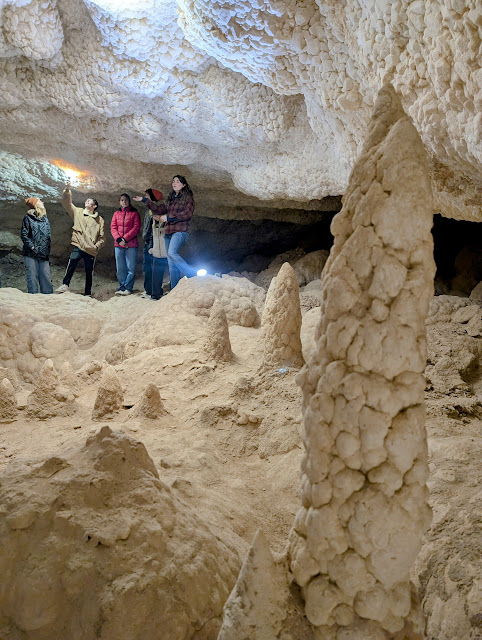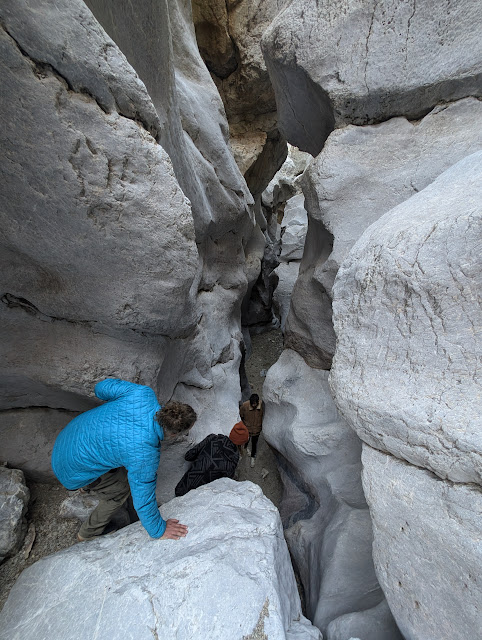Our friends organized a trip to
Crystal Ball Cave and we were happy to join them. This cave is so different and wonderful. We started by going down the Lombardy poplar-lined driveway, where we spotted some peacocks and deer. After meeting our guide Kirsten, we drove up the hill and started on the 15-minute hike to the cave entrance.
Kirsten told us about how her family had discovered the cave while looking for lost sheep. They don't remember what happened to the sheep, but they sure remembered the cave!
The entrance is through a small door.
And then you're in the giant geode! Crystal Ball has thick crystal coatings on most of the ceilings, walls, and floors, caused by supersaturated water. Check out the big crystal by Kirsten's feet!
I've passed this weird looking stalactite several times. Now I understand that it's condensation corrosion that has been weathering away the formation so that we can see the layers that were deposited earlier.
You bring your own lights to light up the cave. Kirsten had a super bright light that really lit up a lot. As you can see, we're walking on the natural cave floor.
I looked closely at this formation. It might resemble a stalagmite at first, but I've seen several of these in Lehman Caves that have a hole through the middle. Sure enough, this one did, too. A gypsum bed was probably at this height, and water drips made a hole into the highly dissolvable gypsum. Then the water splashed to make the popcorny look. So maybe coralloid-encrusted drip tube is a better term for this speleothem. What would you call it?
Gypsum, you say? Why yes, there's a bunch of it in the cave. I don't understand why. You can see drill holes through a bunch of it from dripping water. Why does it confound me? I will be the first to say I have limited geologic knowledge. But I know that gypsum is soluble by water. And in order to have the nailhead spar (crystal coating) in the cave, the cave had to be flooded with water. So that means the gypsum came later. What made it come?
Up on the ceilings are lots of trays, flat surfaces of popcorn. Here's one explanation of how they form (on a really cool website called The Virtual Cave): http://www.goodearthgraphics.com/virtcave/trays/trays.html
There are plenty of more "regular" speleothems, like this nice stalagmite.
And quite a few stalactites and a large stalagmite with draperies on it.
This old ladder heads up into one of the many cupolas in the cave. Cupolas are like upside down sinkholes--they are bigger on the bottom and then get smaller on the top. They form from warm, acidic water rising from below. Cupolas are one of the indications of hypogenic caves, and the more I look at caves in the West, the more I see signs of hypogenesis. Many caves back east, like Mammoth Cave, are epigenic caves, forming when streams sink underground or water flows down sinkholes.
Continuing along, we passed more splattermites and more crystal coatings.
Then we got to this area with more formations that superficially look like stalagmites. But look closer--they're different! They aren't coralloid-encrusted drip tubes either. Instead, these are
raft cones, formed when water filled this pool and calcite rafts (like dainty lily pads) floated on the surface. A drip of water sank a raft, and over time, they built up into these cones. What a weird phenomenon!
Kirsten did such a good job explaining all sorts of things in the cave and answering questions.
She told us about these raft cones and then showed us the weird one, the tall one next to her, which plays two different sounds depending on where you tap on it.
We continued through the cave, where the ceiling gets lower.
But occasionally we could stand again.
That's because there were a bunch more cupolas. Looking up them, we could see the bedrock, because the condensation corrosion had worn away the crystal coating.
The crystals on the floor, continued, though.
They are so beautiful!
In the final room we took our last photos, saw an extinct horse's hoof (this cave is amazing for paleontology), saw a couple bats, and then it was time to go out the exit door.
This door was even shorter than the entrance door.
And then we were back to the outside desert world. The caves with all their decorations remind me that it wasn't always so dry on the surface. Probably many of the formations grew when it was much wetter outside.
We went back to the ranch to use the bathroom and saw these deer hanging out in the orchard next to the guest cabins.
Then it was on to Gandy Warm Springs...
...where Desert Girl waded in...
...and we enjoyed a picnic lunch.
We weren't finished with our adventures yet. Next up was Devil's Gate Slot Canyon.
There's really only one tricky part, the climb down into it. Then there's a very short section of the most beautiful canyon, where you can touch both walls.
And then it suddenly ends.
It was a great day with great people. If you ever have the chance to see Crystal Ball Cave, I highly recommend it!



















































3 comments:
So pretty and unspoiled.
Bates Family Ranch looks like the perfect vacation spot at the right time of year. Warm springs and everything! If I was still traveling...
What a swell way to spend the day. I have quite a collection of crystals and enjoy caves too.
Thanks.
Post a Comment